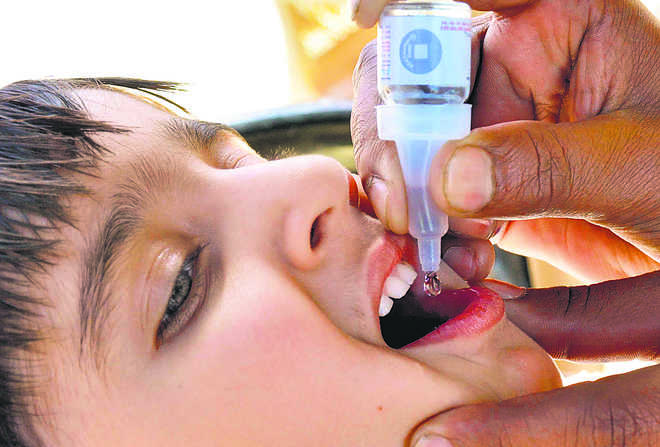
Mission Indradhanush: A supplement to Universal Immunisation Programme.
Rakesh Kumar
Additional Country Director, United Nations Development Programme
Every unimmunised child, as a beneficiary of Mission Indradhanush, tells a story of health and well-being of the entire family and the robustness of the health systems existing in that geographical region. The child is, thus, navigating us to the families/communities where the triple burden — communicable diseases, maternal and child health issues (including malnutrition) and non-communicable diseases — is high.
The unimmunised child is also a source of information for identifying gaps in the healthcare system in India. Furthermore, that the same child, in most probability, may have been adversely impacted by poverty, poor environmental sanitation, poor hygiene, lack of safe drinking water and social barriers for seeking healthcare compounds the problem.
Mission Indradhanush
Mission Indradhanush (MI) was conceived, planned and implemented in 201 worst performing districts of India in 2014 to achieve the milestone of achieving full immunisation coverage (FIC) of more than 90 per cent — keeping the health system strengthening approach at centre-stage and not as a one-time catch-up campaign.
With FIC at 65 per cent in 2013, as many as nine million children and pregnant women were potentially left out and missed out from routine immunisation in India. The tardy annual growth of one per cent would have taken 25 more years to reach the coverage of 90 per cent. Therefore, it was resolved to fast-track the coverage and advance this achievement to 2020.
"Indradhanush", which literally means "a rainbow", is a pertinent metaphor for this huge initiative that aspires to bring various colours of life back to children.
Two years of focussed interventions led by the Ministry of Health and Family Welfare, Government of India, under Mission Indradhanush/Intensified Mission Indradhanush have yielded an impressive increment of close to seven per cent in FIC in one year as compared to one per cent increase per year in the past years.
This initiative has been implemented as a supplement to the Universal Immunisation Programme (UIP) which targets to vaccinate about 27 million children against 12 vaccine preventable diseases every year, more children than any other similar programme in the world achieves, through more than nine million immunisation sessions conducted. The government now aims to achieve 90 per cent immunisation by December 2018.
Simultaneously, India has also done a commendable job of expanding the basket of vaccines by adding Inactivated Polio Vaccine (IPV), Rota Virus Vaccine (RVV), Pneumococcal Conjugate Vaccine (PCV), and Measles and Rubella (MR) vaccine in a short span of time.
Disease in poverty-ridden areas
It is common sense that the pockets and areas with low vaccination coverage cannot be different from those with a high burden of disease. Invariably, these areas are riddled with poor antenatal care, low institutional deliveries, high maternal and child mortality, high incidence of sick and small babies, high levels of maternal and child malnutrition — protein energy malnutrition, micronutrient deficiency, higher incidence of communicable diseases such as TB, malaria, water-borne diseases like diarrhoea, helminthiasis, amoebiasis, typhoid, hepatitis and higher prevalence of tobacco, alcohol and drug abuse and, therefore, more prone to non-communicable diseases. The situation gets compounded by the crippling healthcare delivery systems in that region.
The unimmunised children could be considered as proxy markers of larger public health issues underlying in the family and the community. On the face of it, 'Indradhanush' is an effective approach for improving FIC vaccination programme, but it has a wider canvas to paint in the field of public health.
Significantly, MI should be viewed not only as an isolated strategy to improve maternal and child vaccination in India but also as a potential game-changer to revolutionise the health outcomes across the country by bridging the inequity in access and delivery of healthcare.
Expand the services of MI
To realise the full potential of the MI platform, we need to expand the limited basket of services beyond the vaccines, ORS and common antibiotics which Mission Indradhanush currently provides.
- It is an opportune time to target the families of MI beneficiaries with an expanded package of health services by honing community-based comprehensive primary healthcare through the establishment of Health and Wellness Centres (H&WC) as envisioned under Ayushman Bharat. This would be a milestone on India's path to bridging the inequity to achieve Universal Health Coverage (UHC).
Therefore, development and delivery of the expanded package of services through outreach activities and strengthening of health systems through the establishment of H&WCs in targeted areas must take a front seat.
- Another factor that contributed enormously to the success of MI was a robust communication strategy. Inter-personal communication through accredited social health activists (ASHAs), anganwadi workers (AWWs) and auxiliary nurse mid-wives (ANMs) targeted the families at the grassroot level. Evidence showed that 62 per cent of the parents of unimmunised children either knew nothing about the vaccination (32 per cent) or only knew about the adverse effects (30 per cent).
- To bring in a multiplier effect by positively influencing and engaging the community, we need to invest more in social and behavioural change communication (SBCC) and make that an integral part of the programming. We tend to ignore the power of communication inadvertently and the SBCC remains an appendage to the programme.
Based on the learnings from MI, the decision-makers should prioritise investments under Ayushman Bharat in the areas having the largest number of MI beneficiaries. Otherwise, we risk losing a huge opportunity that Mission Indradhanush presents for improving holistic public health outcomes in India.



























